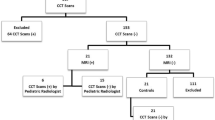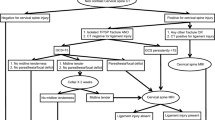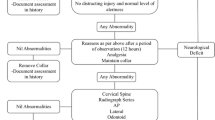Abstract
Purpose
Evaluation of cervical spine injury (CSI) in children requires rapid, yet accurate assessment of damage. Given concerns of radiation exposure, expert consensus advises that computed tomography (CT) should be used sparingly. However, CT can provide superior image resolution and detection of pathology. Herein, we evaluate if X-ray offers equal diagnostic accuracy compared to CT imaging in identifying CSI in children.
Methods
We conducted a retrospective study between October 2000 and March 2012 of pediatric patients evaluated for cervical spine injury at a level 1 trauma center. All patients included in this study were imaged with cervical spine X-rays and CT at the time of injury. Demographic information, mechanism of injury, significant versus non-significant injury (as defined by the NEXUS criteria), radiographic findings, level of the injury, presence of spinal cord injury, treatment, clinical outcome, and length of follow-up were collected. Chi-squared (χ 2) and Fisher’s exact tests were used as appropriate and means and standard deviations were reported.
Results
We identified 1296 patients who were screened for CSI. Of those, 164 patients were diagnosed with spinal cord/column injuries (CSI). Eighty-nine patients were excluded for only having a CT or X-ray imaging without the other modality. Thus, a total of 75 patients with CSI were included in the final cohort. Using the NEXUS definitions, 78% of patients had clinically significant injuries while 22% had non-significant injuries. There were no injuries detected on X-ray that were not also detected on CT. For all injuries, X-ray sensitivity was 50.7%. X-rays were more sensitive to significant injuries (62.3%) compared in non-significant injuries, which were missed on all X-rays (0%). Therefore, X-rays did not identify 24 significant cervical spine injuries (32%) as defined by NEXUS.
Conclusions
CT is superior to X-rays in detecting both clinically significant and insignificant cervical spine injuries. These results were not dependent on patient age or location of the injury. We recommend CT imaging in the evaluation of suspected cervical spine injuries in children.
Level of evidence: III

Similar content being viewed by others
References
Patel JC, Tepas JJ 3rd, Mollitt DL, Pieper P (2001) Pediatric cervical spine injuries: defining the disease. J Pediatr Surg 36:373–376
Hamilton MG, Myles ST (1992) Pediatric spinal injury: review of 61 deaths. J Neurosurg 77:705–708
Duhem R, Tonnelle V, Vinchon M, Assaker R, Dhellemmes P (2008) Unstable upper pediatric cervical spine injuries: report of 28 cases and review of the literature. Child’s nervous system : ChNS : official journal of the International Society for Pediatric Neurosurgery 24:343–348
Leonard JR, Jaffe DM, Kuppermann N, Olsen CS, Leonard JC (2014) Pediatric emergency care applied research network cervical spine study G. Cervical spine injury patterns in children Pediatrics 133:e1179–e1188
Hoffman JR, Mower WR, Wolfson AB, Todd KH, Zucker MI (2000) Validity of a set of clinical criteria to rule out injury to the cervical spine in patients with blunt trauma. National Emergency X-Radiography Utilization Study Group The New England journal of medicine 343:94–99
Viccellio P, Simon H, Pressman BD, Shah MN, Mower WR, Hoffman JR, Group N (2001) A prospective multicenter study of cervical spine injury in children. Pediatrics 108:E20
Chung S, Mikrogianakis A, Wales PW, Dirks P, Shroff M, Singhal A, Grant V, Hancock BJ, Creery D, Atkinson J et al (2011) Trauma association of Canada Pediatric Subcommittee National Pediatric Cervical Spine Evaluation Pathway: consensus guidelines. J Trauma 70:873–884
Booth TN (2012) Cervical spine evaluation in pediatric trauma. AJR American journal of roentgenology 198:W417–425.
Garton HJ, Hammer MR (2008) Detection of pediatric cervical spine injury. Neurosurgery 62:W700–708
Sun R, Skeete D, Wetjen K, Lilienthal M, Liao J, Madsen M, Lancaster G, Shilyansky J, Choi K (2013) A pediatric cervical spine clearance protocol to reduce radiation exposure in children. J Surg Res 183:341–346
Anderson RC, Kan P, Vanaman M, Rubsam J, Hansen KW, Scaife ER, Brockmeyer DL (2010) Utility of a cervical spine clearance protocol after trauma in children between 0 and 3 years of age. J Neurosurg Pediatr 5:292–296
Adelgais KM, Grossman DC, Langer SG, Mann FA (2004) Use of helical computed tomography for imaging the pediatric cervical spine. Acad Emerg Med Off J Soc Acad Emerg Med 11:228–236
Hernandez JA, Chupik C, Swischuk LE (2004) Cervical spine trauma in children under 5 years: productivity of CT. Emerg Radiol 10:176–178
Riascos R, Bonfante E, Cotes C, Guirguis M, Hakimelahi R, West C (2015) Imaging of Atlanto-Occipital and Atlantoaxial Traumatic Injuries: What the Radiologist Needs to Know. RadioGraphics 35: 2121-2134.
Rybicki F, Nawfel RD, Judy PF, Ledbetter S, Dyson RL, Halt PS, Shu KM, Nunez DB Jr (2002) Skin and thyroid dosimetry in cervical spine screening: two methods for evaluation and a comparison between a helical CT and radiographic trauma series. AJR Am J Roentgenol 179:933–937
Jimenez RR, Deguzman MA, Shiran S, Karrellas A, Lorenzo RL (2008) CT versus plain radiographs for evaluation of c-spine injury in young children: do benefits outweigh risks? Pediatr Radiol 38:635–644
Mazonakis M, Tzedakis A, Damilakis J, Gourtsoyiannis N (2007) Thyroid dose from common head and neck CT examinations in children: is there an excess risk for thyroid cancer induction? Eur Radiol 17:1352–1357
Brenner D, Elliston C, Hall E, Berdon W (2001) Estimated risks of radiation-induced fatal cancer from pediatric CT. AJR Am J Roentgenol 176:289–296
Jaffe DM, Binns H, Radkowski MA, Barthel MJ, Engelhard HH 3rd (1987) Developing a clinical algorithm for early management of cervical spine injury in child trauma victims. Ann Emerg Med 16:270–276
Baker C, Kadish H, Schunk JE (1999) Evaluation of pediatric cervical spine injuries. Am J Emerg Med 17:230–234
Nigrovic LE, Rogers AJ, Adelgais KM, Olsen CS, Leonard JR, Jaffe DM, Leonard JC (2012) Pediatric emergency care applied research network cervical spine study G. Utility of plain radiographs in detecting traumatic injuries of the cervical spine in children Pediatric emergency care 28:426–432
Silva CT, Doria AS, Traubici J, Moineddin R, Davila J, Shroff M (2010) Do additional views improve the diagnostic performance of cervical spine radiography in pediatric trauma? AJR Am J Roentgenol 194:500–508
Gale SC, Gracias VH, Reilly PM, Schwab CW (2005) The inefficiency of plain radiography to evaluate the cervical spine after blunt trauma. J Trauma 59:1121–1125
Holmes JF, Akkinepalli R (2005) Computed tomography versus plain radiography to screen for cervical spine injury: a meta-analysis. J Trauma 58:902–905
Como JJ, Diaz JJ, Dunham CM, Chiu WC, Duane TM, Capella JM, Holevar MR, Khwaja KA, Mayglothling JA, Shapiro MB et al (2009) Practice management guidelines for identification of cervical spine injuries following trauma: update from the eastern association for the surgery of trauma practice management guidelines committee. J Trauma 67:651–659
Rana AR, Drongowski R, Breckner G, Ehrlich PF (2009) Traumatic cervical spine injuries: characteristics of missed injuries. J Pediatr Surg 44:151–155
Author information
Authors and Affiliations
Contributions
A.T.H performed literature review, data analysis, study design, and wrote the manuscript. A.A. collected data and performed data analysis. A.K.B. collected data and performed data analysis. G.A.M. critically revised the manuscript. C.M.B. critically revised the manuscript. J.E.M. designed the study and critically revised the manuscript. R.P.N. was involved in all aspects of the manuscript.
Corresponding author
Ethics declarations
Conflict of interest
The authors declare no conflicts of interest.
Rights and permissions
About this article
Cite this article
Hale, A.T., Alvarado, A., Bey, A.K. et al. X-ray vs. CT in identifying significant C-spine injuries in the pediatric population. Childs Nerv Syst 33, 1977–1983 (2017). https://doi.org/10.1007/s00381-017-3448-4
Received:
Accepted:
Published:
Issue Date:
DOI: https://doi.org/10.1007/s00381-017-3448-4




